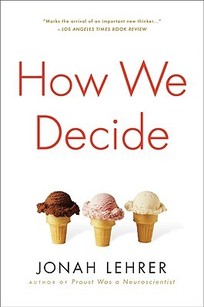
I really enjoyed Jonah Lehrer’s “Imagine” (reviewed last April); so when I saw his earlier book, “How We Decide,” in a remainder pile at Barnes & Noble, it wasn’t a tough decision. That might have been my last cavalier decision.
In “How we Decide” Lehrer puts our decision-making skills under the microscope – kind of like the thinking-person’s self-help manual, promising not only to explain how we decide, but also to help us do it better.
This is not exactly uncharted terrain. Malcolm Gladwell’s “Blink,” explored a similar boundary between reason and intuition. But a key difference between the two books quickly emerges: Gladwell’s book took an external vantage point on its subject, drawing largely on observations from psychology and sociology, while Lehrer’s is an inside job, zooming in on the inner workings of the brain. We learn about the nucleus accumbens, spindle cells and the prefrontal cortex. Many of the experiments he recounts involve fMRI scans of brains in the process of making decisions (which, for the record, is a little like making a decision with your head stuck in a spinning clothes dryer).
Before you throw up your arms – albeit explaining decision-making on the scale of neurons makes for a challenging task – be assured that Lehrer handles it well and often circles back to his central theme: “Sometimes we need to reason through our options and carefully analyze the possibilities. And sometimes we need to listen to our emotions. As an introduction to the cognitive struggle between the brain’s “executive” rational centers and its more intuitive regions, “How We Decide” succeeds with strong storytelling. The neuroscience medicine goes down so smoothly because Lehrer introduces each concept with an arresting anecdote from a diverse array of fields: Tom Brady making a memorable pass in the 2002 Super Bowl; a Stanford particle physicist nearly winning the World Series of Poker; Al Haynes making a remarkable crash landing of a jetliner whose hydraulic system had failed entirely. These anecdotes are the hooks upon which we non-brain scientists can hang the lessons of “How We Decide.”
Lehrer’s insights go well beyond the name-that-neurotransmitter trivia. Perhaps the most interesting suggestion is that the more complex a decision, the more we should rely on our emotional brain, which is much better at synthesizing from past failures than our rational mind is at constructing future “right” decisions.
In “How we Decide” Lehrer puts our decision-making skills under the microscope – kind of like the thinking-person’s self-help manual, promising not only to explain how we decide, but also to help us do it better.
This is not exactly uncharted terrain. Malcolm Gladwell’s “Blink,” explored a similar boundary between reason and intuition. But a key difference between the two books quickly emerges: Gladwell’s book took an external vantage point on its subject, drawing largely on observations from psychology and sociology, while Lehrer’s is an inside job, zooming in on the inner workings of the brain. We learn about the nucleus accumbens, spindle cells and the prefrontal cortex. Many of the experiments he recounts involve fMRI scans of brains in the process of making decisions (which, for the record, is a little like making a decision with your head stuck in a spinning clothes dryer).
Before you throw up your arms – albeit explaining decision-making on the scale of neurons makes for a challenging task – be assured that Lehrer handles it well and often circles back to his central theme: “Sometimes we need to reason through our options and carefully analyze the possibilities. And sometimes we need to listen to our emotions. As an introduction to the cognitive struggle between the brain’s “executive” rational centers and its more intuitive regions, “How We Decide” succeeds with strong storytelling. The neuroscience medicine goes down so smoothly because Lehrer introduces each concept with an arresting anecdote from a diverse array of fields: Tom Brady making a memorable pass in the 2002 Super Bowl; a Stanford particle physicist nearly winning the World Series of Poker; Al Haynes making a remarkable crash landing of a jetliner whose hydraulic system had failed entirely. These anecdotes are the hooks upon which we non-brain scientists can hang the lessons of “How We Decide.”
Lehrer’s insights go well beyond the name-that-neurotransmitter trivia. Perhaps the most interesting suggestion is that the more complex a decision, the more we should rely on our emotional brain, which is much better at synthesizing from past failures than our rational mind is at constructing future “right” decisions.
To be tweeted links to my new posts -- blog, book reviews (both nonfiction and fiction), data or other recommended tools -- either go to Twitter.com and follow me @jcrubicon, or just go to my Home page and click on the Twitter button on the right, just above the tweet stream, and follow me @jcrubicon.
 RSS Feed
RSS Feed
